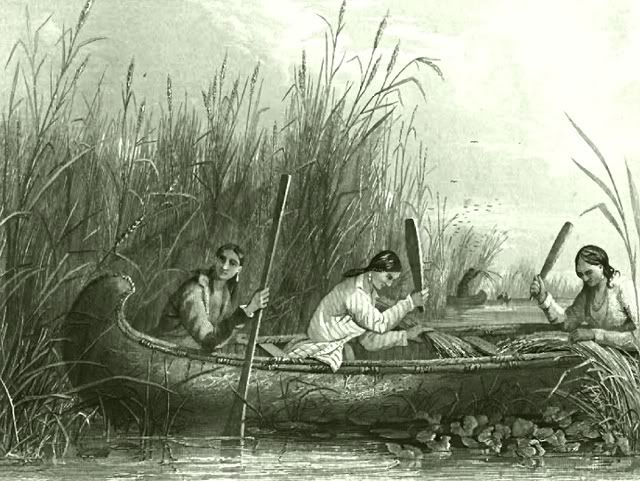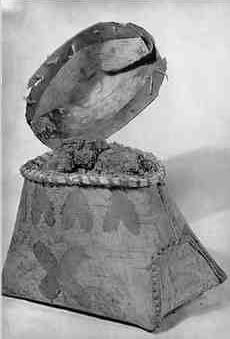( – promoted by navajo)
The western Great Lakes area was inhabited by Algonquian-speaking tribes such as the Anishinabe (Ojibwa or Chippewa), Kickapoo, Potawatomi, Menominee, Shawnee, Ottawa, and Sauk and by Siouan-speaking groups such as the Winnebago, Iowa, Oto, and Missouria. Like the other Indian nations of the Eastern Woodland, all of the tribes knew about farming and engaged in it. However, among the Algonquian-speaking people of this area, farming was of secondary economic importance (hunting and gathering were of greater importance) and contributed less than half of their food. Two of the important wild foods for these tribes were wild rice and maple sugar.
Wild Rice:
One of the important foods to many of the people in the western Great Lakes area, such as the Menominee and the Chippewa, was, and still is, wild rice-manoomin in Anishinabe. Wild rice is highly nutritious and provided a significant portion of the calories traditionally consumed by the tribes in the area.
Northern wild rice (zizania palustris) is an annual plant native to the Great Lakes region. Wild rice grows in the shallow water of lakes and slow-flowing streams. Wild rice is high in protein, the amino acid lysine, and dietary fiber. It is low in fat and does not contain gluten.
The rice fields were owned by families. The rice was harvested by poling canoes through the tall rice stalks. The stalks were then pulled over the gunwales of the canoe and the ripe grain knocked into the bottom of the canoes with a short stick. In a period of 4-6 hours, a pair of women in a canoe could harvest over 100 pounds of grain.

The rice was then cleaned, sun dried, and cooked. The rice would be dried by spreading it evenly on sheets of birch bark. The young men and boys would help in the threshing of the rice to remove the close-fitting hull. They would walk on the grain or churn it with a paddle. The rice would then be winnowed by tossing it into the air and letting the wind blow the chaff away. If there was no wind, the rice would be spread out on a mat or blanket and fanned. Some of the prepared rice would be cached for later use by storing it in sewn animal skins or in covered birch bark boxes (makakon). Prepared rice would keep indefinitely.
To insure a continuing yield, a portion of the rice kernals were encased in mud and then tossed back into the water. A typical family would gather 12-15 bushels of rice each year.
Among the Anishinabe of Minnesota, the rice-gathering season, known as mahnominike-gizis (“rice-making moon”), was a time of feasting and ceremonies. No rice was taken until an offering was made to the plants in thanksgiving. The wild rice feasts were both social pastimes and religious ceremonies. The wild rice feasts brought the people together and provided them with both food and spiritual sustenance.
Like the Anishinabe, the Menominee also gathered wild rice as one of their major food resources. In processing the wild rice, they would dig a pit and then place a deer skin or mat in the pit. The rice would then be placed on top of this. To separate the grain from the chaff, the women and children would then dance on the rice. The deer skins and mats would be pulled out and shaken to get rid of the chaff. Once dried, the rice would be stored in pits for winter use.
Maple Sugar:
Another important food for the Indian nations in the Great Lakes area was maple sugar. This was more than something good to eat: the maple sugar symbolized good relations between people and harmony between the people and the natural and supernatural worlds. In addition, maple sugar was easy to transport and lasted a long time. The Anishinabe called it iinzibaakwad.
In many areas, the maple sap would become available before the fish in the spring so the people would begin to gather at the sugar bush groves before moving on to their fishing areas. Among the Chippewa and Ottawa in Michigan, several related families would camp together while harvesting the sap.
Among the Anishinabe in Minnesota, the making of the maple sugar began in late March or early April with the arrival of the first crow. The entire village would then move to the maple area where they would tap the trees, boil the sap down, and separate it into syrup, sugar, and cakes. The maple sap was collected in birch bark containers which were made by folding the ends of a rectangular piece of bark and tying it with willow. A gash would be cut in the tree and a cedar chip driven in under the gash. The basket would be placed on the ground under the chip to catch the sap as it dripped. In a good season, a family would prepare 400-500 pounds of sugar.
The sap would be processed first by boiling. Prior to the coming of the European traders and their metal pots, the sap was boiled in bark baskets or troughs. Rocks would be heated and then dropped into the sap, which would bring it to a boil. When it had reached a proper consistency, it would be transferred to a granulating trough where it would be worked with a paddle until it was in the form of granulated sugar.
The maple sugar was used in preparing fruits, wild rice, vegetables, and fish. In the summer, a cool drink was made by dissolving the maple sugar in water. Finally, the maple sugar was also used to make confections which were enjoyed by the children (and probably by the adults as well).

Leave a Reply